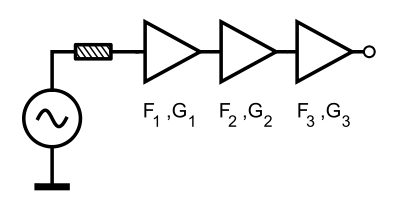Friis formulas for noise
Friis formula or Friis's formula (sometimes Friis' formula), named after Danish-American electrical engineer Harald T. Friis, is either of two formulas used in telecommunications engineering to calculate the signal-to-noise ratio of a multistage amplifier. One relates to noise factor while the other relates to noise temperature.
The Friis formula for noise factor

Friis's formula is used to calculate the total noise factor of a cascade of stages, each with its own noise factor and power gain (assuming that the impedances are matched at each stage). The total noise factor can then be used to calculate the total noise figure. The total noise factor is given as
where and are the noise factor and available power gain, respectively, of the i-th stage, and n is the number of stages. Both magnitudes are expressed as ratios, not in decibels.
Consequences
An important consequence of this formula is that the overall noise figure of a radio receiver is primarily established by the noise figure of its first amplifying stage. Subsequent stages have a diminishing effect on signal-to-noise ratio. For this reason, the first stage amplifier in a receiver is often called the low-noise amplifier (LNA). The overall receiver noise "factor" is then
where is the overall noise factor of the subsequent stages. According to the equation, the overall noise factor, , is dominated by the noise factor of the LNA, , if the gain is sufficiently high. The resultant Noise Figure expressed in dB is:
Derivation
For a derivation of Friis' formula for the case of three cascaded amplifiers () consider the image below.

A source outputs a signal of power and noise of power . Therefore the SNR at the input of the receiver chain is . The signal of power gets amplified by all three amplifiers. Thus the signal power at the output of the third amplifier is . The noise power at the output of the ampifier chain consists of four parts:
- The amplified noise of the source ()
- The output referred noise of the first amplifier amplified by the second and third amplifier ()
- The output referred noise of the second amplifier amplified by the third amplifier ()
- The output referred noise of the third amplifier
Therefore the total noise power at the output of the amplifier chain equals
and the SNR at the output of the amplifier chain equals
- .
The total noise factor may now be calculated as quotient of the input and output SNR:
Using the definitions of the noise factors of the amplifiers we get the final result:
- .
The Friis formula for noise temperature
Friis's formula can be equivalently expressed in terms of noise temperature:
Published references
- J.D. Kraus, Radio Astronomy, McGraw-Hill, 1966.